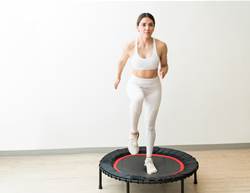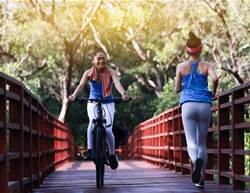Watching a baby scoot about on the floor is so adorable that baby crawl races get millions of views on YouTube—but you probably don’t think to do it yourself. And yet, crawling exercises, such as bear crawls, are a growing trend in the fitness world, where it’s also known by some fancier names like quadrupedal movement training (QMT) or primal movement training. Some of the most common primal exercises include bear crawls, crab walks, froggers, and other animal-inspired exercises.
What are the health benefits of bear crawls and crawling exercise?
Granted, these QMT moves look a little silly. But there are many serious benefits to sprinkling these fun bodyweight exercises into your regular fitness routine. They’ll work your abs, boost your heart rate, improve coordination, and more. Here’s what the experts have to say about the benefits of primal movement:
Bear crawls work out your entire body—including your abs
Babies and animals make moving on all-fours look super easy, but don’t let that fool you. Crawling-type exercises are total body workouts in and of themselves. In fact, the legs, arms, and many of the smaller stabilising muscles of our body have to work together to push you up off the ground and keep you from falling flat on your face.
“When we’re doing quadrupedal movement, there are very few muscles that get to lay dormant,” says Mike Fitch, fitness educator and movement coach. “Every muscle has to play some sort of role, whether it be stabilising, accelerating, or decelerating. So we're looking at total body muscular conditioning.”
And guess what? That “total body conditioning” also includes your core, according to physiotherapist, Jarlo Ilano. When you crawl, there's a natural rotation across your trunk that engages your core muscles in a way that similar to doing bicycle crunches or rotational chops with a cable machine, he says. The bonus with crawling, though, is that you don't have to think so hard about “bracing your core” or “squeezing your abs” to get all the benefits.
“As soon as you get on all-fours, your body automatically engages the core,” adds Ilano. Otherwise, you’d topple over.
So if you’re tired of crunches and sit-ups, you may want to toss in some froggers or bear planks to spice up your ab routine.
Crawling is great cardio
Running, jogging, and walking aren’t the only options to get in good cardio. According to Fitch, quadrupedal movements can get your heart rate up, even at slower paces.
“I think most people think of cardiovascular work is working at really high intensities,” says Fitch. “But when we’re using so much of our body—when so many of our muscles are having to work together in unison—we’re going to require a lot of oxygen to perform the task. This means that crawling movements have a high cardiovascular demand.”
Bear crawls may help you move with more ease
Whether your hips and knees are stiff from sitting at a desk all day or your calves are tight from a lot of walking, mobility work can help to loosen you back up and save you from a lot of aches and pains. Primal movements can be used as part of your dynamic mobility drills or warmups, according to Ilano.
Mobility, refers to a joint's active ability to move freely and easily through its full range of motion. So, think about the degree to which your shoulder rotates as you lift your hand overhead to wave to a friend, or how low your knees will allow you to go during a game of limbo.
This is unlike flexibility, which is about how far your muscles can passively lengthen—like when your physical therapist pushes your leg back for a hamstring stretch. Mobility requires that your body has enough strength to control the movement through a given range on its own.
Crawling has been proven to be effective at increasing that strength and control, particularly in the shoulders and hips. A 2020 study found that people who did one-hour of QMT training per week for 16 weeks significantly increased their shoulder and hip mobility. For you this might mean having an easier time grabbing your luggage from the overhead compartment, or feeling more comfortable sitting down and getting up from a chair.
Crawling may improve brain function
Many child therapists and researchers have talked about how the crawling stage can have a major impact on an infant's brain development. As babies explore the world on their hands and knees, they are developing neural connections that help them with cognitive processes like memory, hand-eye coordination, and spatial awareness.
It also turns out that crawling can be beneficial for adult brains, too.
In 2015, experts conducted a small study (now published in Human Movement Science) looking at how 60-minute QMT sessions per week affected the brain. After four-weeks the scientists discovered that the subjects’ cognitive flexibility — the ability to adapt behaviour in response to changes in the environment — significantly improved. Other researchers suggest that cognitive flexibility is important when it comes to solving problems, changing perspective, and cutting out distractions to focus on what's important for whatever task is at hand.
Crawling can increase coordination and mind-body connection
If you don’t consider yourself to be the most graceful person, crawling may help you feel more tune in with your body.
“Contralateral movement—or opposite hand and foot movement—actually helps to condition the communication between the left and right hemisphere of the brain,” says Fitch. This increased communication strengthens neural connections that can improve coordination.
Crawling can also be very grounding, adds Fitch. Literally and figuratively.
Many of us use exercise to de-stress from a long day, but unless we are performing a movement that's highly technical or requires a lot of focus, our minds can still wander to that tough conversation we had with our boss or all the things we have to do the next day, he says. But whenever we place our hands and feet on the ground, it's harder to think about anything else besides keeping yourself from crashing.
“We have a have high number of sensory receptors on our hands and feet,” says Fitch. “So when we put them all on the floor, they are sending so much information about pressure, force, temperature, texture and more to the spinal cord and brain. In order to move, you really have to focus, and this can develop extra awareness and mindfulness. It's an opportunity to reconnect with your system.”
How to bear crawl and other primal movement workouts for beginners:
While many QMT moves are great to just mix into your traditional training circuits, you can dedicate an entire workout to bear crawls if you wanted to. Here are some of the best beginner workouts you can try and discover for yourself how dynamic this type of training can be.
Primal Movement Crawls by Naturaletics
In this video, you will learn how to do five different primal movements with yoga blocks. This one is great for people who are experiencing challenges with their hip, knee, or ankle mobility. Pick a few movements you like and explore them for 5 to 10 minutes as part of your warm up or your workout for the day.
Bear Crawl Workout by GMB
The bear crawl is one of the most basic moves you can learn and there's more than one way to do it. In this video you'll find all sorts of versions that you can explore. Set your timer anywhere from 5-10 minutes, play around with them, and see which type of bear crawl you like.
Tips for incorporating bear crawls into your workouts:
Before you jump in to embodying your inner child, here are a few tips to ease yourself in and make bear crawling, primal movement, QMT, or whatever you like to call it an enjoyable and beneficial part of your workout routines.
- Always warm up your wrists first. “Because we’re not used to being on our hands, we have to make sure your wrists and hands are warmed up,” says Ilano. This is especially true for a lot of us who spend so much time with our wrists flexed over our computer keyboards. Crawling requires your wrists to be in extension (think: holding a tray in each hand with the palms up) for an extended period of time. Without a warm up, that position can feel kind of achy, according to Ilano. Not sure how to prep? Fitch suggests “wrist rolls”: Clasp you hands together and roll them over and around each other for 30 seconds then switch to the other direction.
- Start slow. When you’re just getting started, you'll want to ease your body into learning a new way to move. No need to do an hour-long session of quadrupedal training, especially in the beginning. Ilano recommends adding one or two of your favourite crawls to your warm up or adding a 10 minute play break in the middle of your workout session. During that play time, break things up. For example, you can crawl for 20 seconds then rest until you're ready to go again for another 20, and keep repeating until your time is up.
- When you’re feeling tight, modify. Getting into a deep squat for a frog hop or straightening your legs out for a bear crawl can be challenging. Luckily, there are many ways to modify these moves to fit your body. For instance, for a straight-legged bear crawl, it’s okay to keep your knees bent when your hamstrings are feeling tight, says Ilano. If your hips, knees, or ankles are feeling too cranky to sit into a deep ape, you can elevate your hands to yoga blocks, a bench, or chairs, so that you don't have to squat as low, according to Fitch. If you're not sure how to modify a movement for your body, it's best to consult a movement expert who's knowledgable about QMT who can find a movement that's better for you or make the proper adjustments.










